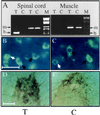Acetylcholinesterase-transgenic mice display embryonic modulations in spinal cord choline acetyltransferase and neurexin Ibeta gene expression followed by late-onset neuromotor deterioration
- PMID: 9223334
- PMCID: PMC21576
- DOI: 10.1073/pnas.94.15.8173
Acetylcholinesterase-transgenic mice display embryonic modulations in spinal cord choline acetyltransferase and neurexin Ibeta gene expression followed by late-onset neuromotor deterioration
Abstract
To explore the possibility that overproduction of neuronal acetylcholinesterase (AChE) confers changes in both cholinergic and morphogenic intercellular interactions, we studied developmental responses to neuronal AChE overexpression in motoneurons and neuromuscular junctions of AChE-transgenic mice. Perikarya of spinal cord motoneurons were consistently enlarged from embryonic through adult stages in AChE-transgenic mice. Atypical motoneuron development was accompanied by premature enhancement in the embryonic spinal cord expression of choline acetyltransferase mRNA, encoding the acetylcholine-synthesizing enzyme choline acetyltransferase. In contrast, the mRNA encoding for neurexin-Ibeta, the heterophilic ligand of the AChE-homologous neuronal cell surface protein neuroligin, was drastically lower in embryonic transgenic spinal cord than in controls. Postnatal cessation of these dual transcriptional responses was followed by late-onset deterioration in neuromotor performance that was associated with gross aberrations in neuromuscular ultrastructure and with pronounced amyotrophy. These findings demonstrate embryonic feedback mechanisms to neuronal AChE overexpression that are attributable to both cholinergic and cell-cell interaction pathways, suggesting that embryonic neurexin Ibeta expression is concerted in vivo with AChE levels and indicating that postnatal changes in neuronal AChE-associated proteins may be involved in late-onset neuromotor pathologies.
Figures






Similar articles
-
Transgenic acetylcholinesterase induces enlargement of murine neuromuscular junctions but leaves spinal cord synapses intact.Neurochem Int. 1998 May-Jun;32(5-6):449-56. doi: 10.1016/s0197-0186(97)00121-6. Neurochem Int. 1998. PMID: 9676744
-
Regulatory region in choline acetyltransferase gene directs developmental and tissue-specific expression in transgenic mice.Proc Natl Acad Sci U S A. 1995 Apr 25;92(9):4046-50. doi: 10.1073/pnas.92.9.4046. Proc Natl Acad Sci U S A. 1995. PMID: 7732028 Free PMC article.
-
Colocalization of acetylcholinesterase, butyrylcholinesterase and choline acetyltransferase in rat spinal cord.Hum Exp Toxicol. 2005 Oct;24(10):543-5. doi: 10.1191/0960327105ht560oa. Hum Exp Toxicol. 2005. PMID: 16270756
-
[Acetylcholinesterase activity, choline acetyltransferase and GABA immunoreactivity in the ventral horn of the spinal cord of rats during chromatolysis].Rev Neurol (Paris). 1989;145(1):55-9. Rev Neurol (Paris). 1989. PMID: 2646682 Review. French.
-
Structural roles of acetylcholinesterase variants in biology and pathology.Eur J Biochem. 1999 Sep;264(3):672-86. doi: 10.1046/j.1432-1327.1999.00693.x. Eur J Biochem. 1999. PMID: 10491113 Review.
Cited by
-
Upregulation of neuronal nicotinic receptor subunits alpha4, beta2, and alpha7 in transgenic mice overexpressing human acetylcholinesterase.J Mol Neurosci. 2002 Jun;18(3):211-22. doi: 10.1385/JMN:18:3:211. J Mol Neurosci. 2002. PMID: 12059039
-
Synaptogenesis and myopathy under acetylcholinesterase overexpression.J Mol Neurosci. 2000 Feb-Apr;14(1-2):93-105. doi: 10.1385/JMN:14:1-2:093. J Mol Neurosci. 2000. PMID: 10854041
-
Genomic dissection reveals locus response to stress for mammalian acetylcholinesterase.Cell Mol Neurobiol. 2001 Dec;21(6):783-97. doi: 10.1023/a:1015112407079. Cell Mol Neurobiol. 2001. PMID: 12043848 Free PMC article.
-
Excess "read-through" acetylcholinesterase attenuates but the "synaptic" variant intensifies neurodeterioration correlates.Proc Natl Acad Sci U S A. 2000 Jul 18;97(15):8647-52. doi: 10.1073/pnas.140004597. Proc Natl Acad Sci U S A. 2000. PMID: 10890884 Free PMC article.
-
Bridging the synaptic gap: neuroligins and neurexin I in Apis mellifera.PLoS One. 2008;3(10):e3542. doi: 10.1371/journal.pone.0003542. Epub 2008 Oct 31. PLoS One. 2008. PMID: 18974885 Free PMC article.
References
Publication types
MeSH terms
Substances
LinkOut - more resources
Full Text Sources
Other Literature Sources
Molecular Biology Databases

